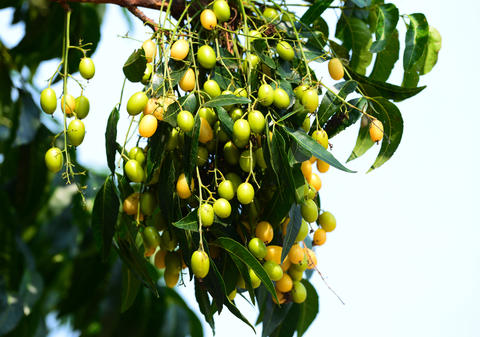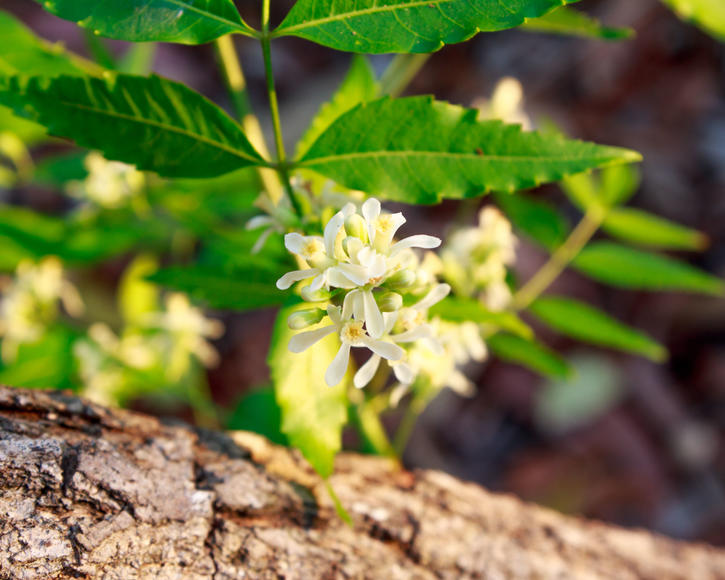Neem oil
Neem oil is an eco-friendly product, which is known to many hobby gardeners as a miracle cure against pests. This is how the exceptional oil is made and used in the garden.
Neem oil, also known as neem, is an eco-friendly product that has been used for plant-based pest control. The precious oil is extracted from the flowers of the neem tree (Azadirachta indica). The evergreen tree, which is also called Indian lilac, is a relative of the mahogany trees. It is primarily found in east India and Bangladesh. Moreover, it is also cultivated in Africa, America and Australia as crop plants and ornamental plants. The Neem tree is gaining popularity because it has no special requirements. The undemanding plant also withstands warm and damp weather without sustaining any damage.
The special neem oil can be produced by three different methods. But before producing the valuable extract, the tree blossoms have to be harvested between January and April. The fruit that has fallen from the tree is also collected and then processed. To do this, the pulp is removed and the seeds broken open.

One way to make neem oil is by the water extraction method. This method, while not the most effective, is fairly inexpensive. To do this, the kernels are ground and then placed in water until the desired extract is obtained.
The second, much more effective method of producing the oil is extraction with hexane — a saturated hydrocarbon — and alcohol. With the help of hexane, the neem oil is first removed from the kernels. Finally, all remaining hexane residues are removed with a suitable solvent. The extraction with alcohol then proceeds in the same way. This second extraction step is necessary because not all ingredients (e.g. limonoids) are hexane-soluble.

The last method used to make neem oil is cold pressing. The kernels are gently cold-pressed, which results in the highest quality neem oil. Cold-pressing makes the naturally yellow-colored and bitter-smelling oil paler in color and slightly less intense in smell. Residues, if any, are completely removed in this method, hence this is considered the best method of extraction.
The rural population of Asia and Africa has long known that the neem tree keeps insects away and has a pest-repellent effect. Its been only a few years that neem oil has been used to specifically combat plant pests and parasites in humans and animals. A very well-known neem product is, for example, Niemolind. It is used in the treatment of head lice.
But the neem tree offers other advantages: In many places, a brew is made from the leaves of the neem tree. This has an antibacterial and anti-inflammatory effect, for example against fever.

In India, the special tree with its broad crown provides people with plenty of shade and good wood to make furniture. In Africa, people eat the greenish-yellow fruit found inside the flower.
It is versatile because different parts of the tree are used in making various different end products. Not only the roots, fruits and leaves also affect the mode of action of the end product. The cultivation location, season and extraction processes also have a significant impact.
As mentioned before, neem products are primarily used against a variety of pests. In crop protection, the natural preparations are mainly used against biting and sucking pests such as beetles, caterpillars, lice and title. Snails and fungal infections can also be treated with neem oil.
In the event of an acute pest infestation, spray the neem oil directly onto the leaves of the affected plant. You can also add neem oil to water and use that for watering the plants. This way, the plants absorb the oil through the roots and are strengthened from the inside out.
Infested plants are best sprayed with diluted neem oil early in the morning. So you can be sure that all ravenous pests will come into contact with the preparation throughout the day. The pests do not die immediately after contact with neem oil, so you need to be a bit patient.
Neem oil should not be sprayed when it is raining, otherwise the product can easily be washed off and lose its effectiveness. Spraying in strong sunshine should also be avoided. Otherwise there is a risk of burns to the leaves of the plant. If your plants are not yet infested or only slightly infested, you can also use neem oil as a preventive measure. Simply add a small amount of the oil to the water.
Pure neem oil can be found in any well-stocked garden center or on the Internet. There are also ready-to-use mixes available for spraying or to be added to the water. If you plan to use pure neem oil, you need to take care of the correct dosage while mixing. Depending on the pest infestation, a few milliliters of the oil per liter of water are sufficient.

Ideally, store neem oil in a cool and dark place to ensure the longest possible shelf life.
Neem preparations contain a large number of active ingredients, but the most important ingredient is the pest-repellant azadirachtin. Pests cannot identify the main active ingredient of the oil as exogenic (foreign substance) and therefore enter the metabolic cycle in a fast and reliable way. Once there, it affects the hormonal balance of the animals: Chitin synthesis is inhibited, with the result that the affected animals are no longer able to fully develop their protective exoskeleton. The development of the insect larvae and pupae is also inhibited, the next step in the growth cycle does not take place. The pests are completely eliminated after a few days and the plant is pest-free again.
Other substances such as salannin, nimbin and nimbidin have a deterrent effect on the pests due to their bitter taste and smell. Meliantriol spoils the appetite of unwanted animals, so that the plant is protected from being eaten away.
In addition to conventional neem oil, there are also other useful preparations such as neem oil cakes. This is made from the residue left behind after the neem oil preparation. Neem oil cake can be used in many ways, for example as a mild fertilizer with an insecticidal effect or as animal feed. Neem oil cake acts as a natural fertilizer and is also rich in nutrients. Concentrated nitrogen fertilizers or liquid manure are better processed in the soil with neem oil cakes. One kilo of the neem product costs around 20 euros.
To enrich your soil, mix around 30 grams of neem oil cake with one liter of water. Then let the mixture steep for a few hours. Sieve off bigger pieces in the mixture and then spray or douse the affected plants with the water extract. As a pure soil additive, about 0.35 ounces of neem oil cake per 35.37 ounces of soil is required for seeds and seedlings. For older plants, up to 1.76 ounces per 2 lbs of soil can be used. If using urea fertilizers or liquid manure, add approximately three percent of neem oil cake and mix well.
The mixture of neem seeds and neem oil cake is called Humeen-Neem fertilizer, it works as an organic NPK fertilizer. About 1.05 ounces of the fertilizer is mixed per liter of potting soil, or about 0.17 ounces per plant for young plants. 1.05 ounces of the mixture per liter of water is stirred into the pouring water. Regular use improves the long-term effect of fertilizers, as an abrupt release of fertilizer is prevented.
The active ingredient of the neem flower is also found in small quantities in many drugstore products such as toothpaste, soap or shampoo.

